
Dorothea Tanning
Endgame, 1944
While games may seem a trivial luxury, they have existed since the beginning of humanity. According to Dutch historian Johan Huizinga, games are a direct result of the human condition, and foundational elements for language, philosophy, art, and strategic thinking. While entertainment is one of the primary pursuits for game-playing, there are more complex and crucial reasons for the persistence of games throughout all cultures.
Senet, for example, an Egyptian board game dating back to 3100 BC, was imbued with ritual significance, while Gyan Chauper, an Indian game from the 13th century, was played to teach moral and spiritual lessons. Games not only entertain, but also encourage social interaction, learning, and the passing of culture from generation to generation. Considering this, it is no wonder that so many of the games we are familiar with today come from long traditions that span across international empires.

Senet
Egyptian, 1550–1295 B.C.

Senet
Egyptian

Gyan Chaupar
India

Gyan Chaupar
India
Chess, one of the world’s most popular strategic thinking games, continued to develop around the globe for hundreds of years. Originating in India in the 6th century, it later expanded to Persia and became popular across the Muslim world before spreading to Southern Europe. The 15th century European style of chess, similar to the version played today, emphasized quick and tactical gameplay rather than long-term strategy. Players quickly adapted this rapid format and in 1886, the first World Chess Championship was held in the United States.
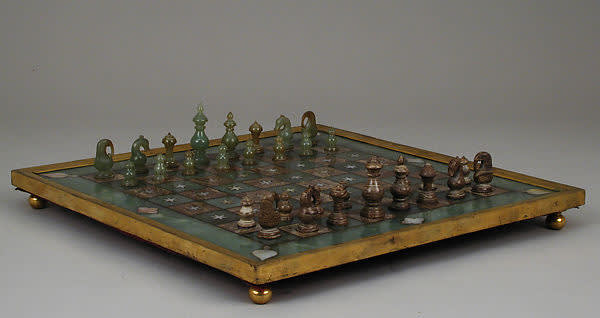
Chess Set
1800s

Chess Set
1800s

Max Esser
German Chess Set, 1932
Modern inventions of the 20th century, namely computers, saw major leaps in gameplay theory, beginning in the 1970s when computer analysis was first used to develop chess strategy. The monumental 1997 ‘Deep Blue versus Garry Kasparov’ match saw the first instance of a computer beating a world champion. Thanks to both the game’s withstanding nature and the development of online gaming, chess remains a popular pastime today, with over 600 million adults playing worldwide. In turn, chess has also had significant influence on other parts of culture, namely the art world, where many artists have expressed the nature of the game in their works.
Marcel Duchamp and Salvador Dalí
Playing Chess
Marcel Duchamp
Portrait, Playing Chess
Marcel Duchamp
Playing chess in his studio, 1952
George Koltanowski and Marcel Duchamp
The Imagery of Chess Invitation, 1944
Chess Player
Lisa Lane at Marshall Chess Club in Greenwhich Village, 1962
Marcel Duchamp
Playing chess with Eve Babitz, 1964
Marcel Duchamp
Chess Set at Home
20th century artist Marcel Duchamp became a professional chess player after learning to play from his brothers in a Cubist circle outside of Paris. The influence of Cubism and the game of chess inspired several of Duchamp’s early works, including a Post-Impressionist painting from 1910 “The Chess Game”, and the 1911 Cubist work titled, “Portrait of Chess Players.” In Brussels, Duchamp joined a chess club and began competing in tournaments, where he developed a friendship with famed player George Koltanowski. In New York, Duchamp and Koltanowski founded the Greenwich Village Chess Club in 1942, where Duchamp hand-made foldable chess sets that Koltanowski then sold on tours. In a 1944 collaboration, Duchamp and Koltanowski exhibited “The Imagery of Chess,” where Koltanowski played seven simultaneous games while blindfolded. The exhibition also featured works by Alexander Calder, Max Ernst, Man Ray, Yves Tanguy, and 28 other artists. Duchamp’s connection between chess and art was exemplified in his address to the New York Chess Association, where he asserted that, “While all artists are not chess players, all chess players are artists.”

Marcel Duchamp
The Chess Game, 1910

Marcel Duchamp
Portrait of Chess Players, 1911
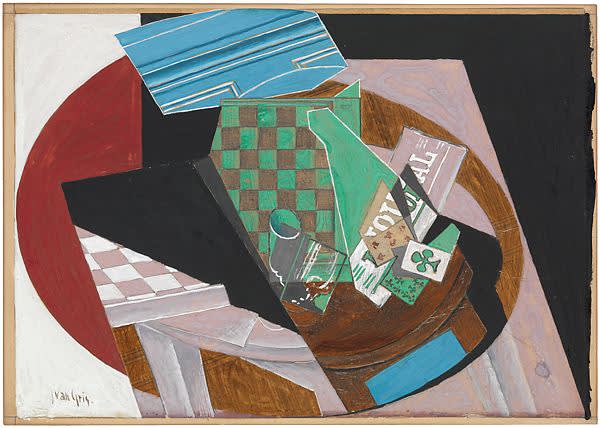
Juan Gris
Checkerboard and Playing Cards, 1915

Man Ray
Chess Set with Board, 1944

Man Ray and Marcel Duchamp
Playing chess with Man Ray's chess set
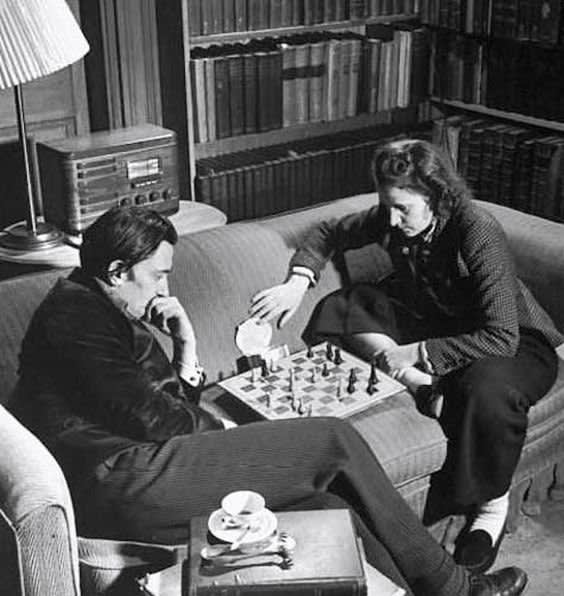
Gala and Salvador Dalí
Playing chess, 1941
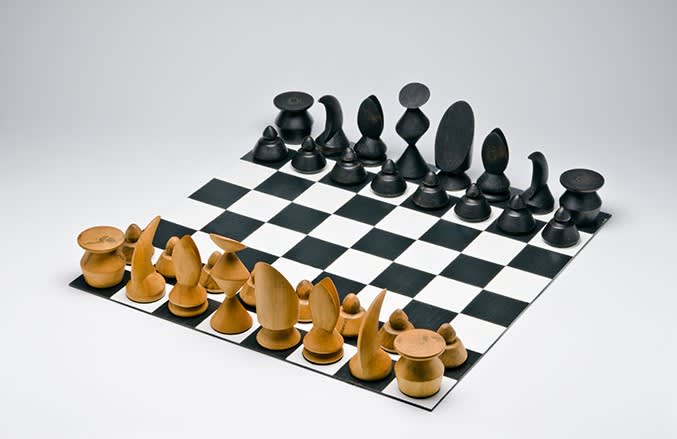
Max Ernst
Chess Set, 1944

Max Ernst
With his Chess Set, 1945

Max Ernst and Dorothea Tanning and Muriel and Julien Levy
Playing Chess, 1945

Alexander Calder
Chess Set, 1944

Arshile Gorky
Study for a Delicate Game, 1946

The Bauhaus
Chess Set
Like Duchamp, other artists have found both companionship and inspiration in the game of chess. Surrealists Max Ernst and Dorothea Tanning allegedly fell in love over a game of chess, while Tanning’s painting “Endgame,” from 1944, exemplifies this in a surrealist depiction of a chess board. Abstract Expressionist Arshile Gorky depicted the game in an untitled crayon drawing in 1946, commonly known as “Study for a Delicate Game,” while artists such as Man Ray and Alexander Calder have even remade the classic chess set in their own visual language, with Man Ray using geometric forms and found objects, and Calder changing the traditional colors to red and blue pieces sculpted from wood.
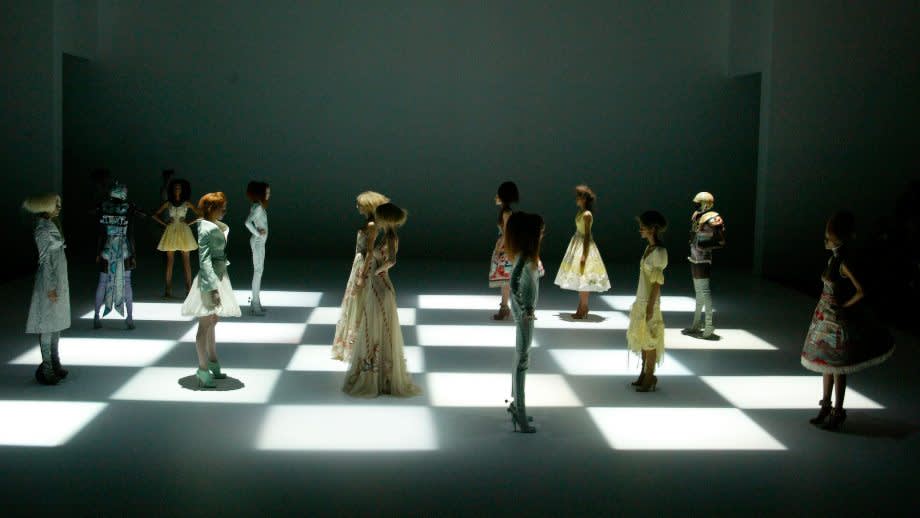
Alexander McQueen
Spring/Summer 2005

Alexander McQueen
Spring/Summer 2005

Alexander McQueen
Spring/Summer 2005

Christian Dior
Couture, Spring/Summer 2018

Christian Dior
Couture, Spring/Summer 2018

Christian Dior
Couture, Spring/Summer 2018

Christian Dior
Couture Spring/Summer 2018

Christian Dior
Couture, Spring/Summer 2018

Christian Dior
Couture, Spring/Summer 2018
Even the fashion world has found inspiration in the game; Alexander McQueen’s famous Spring/Summer 2005 show was set on a chess board, with models in Edwardian-inspired clothing acting as the pieces and moving about the board. Similarly, Maria Grazia Chiuri’s Spring/Summer 2018 Couture show for Dior, was set against a black and white checkerboard with surrealist sculptures hanging from the ceiling. The collection even referenced other popular games, with one dress mimicking a domino.

Monopoly
Original Patent
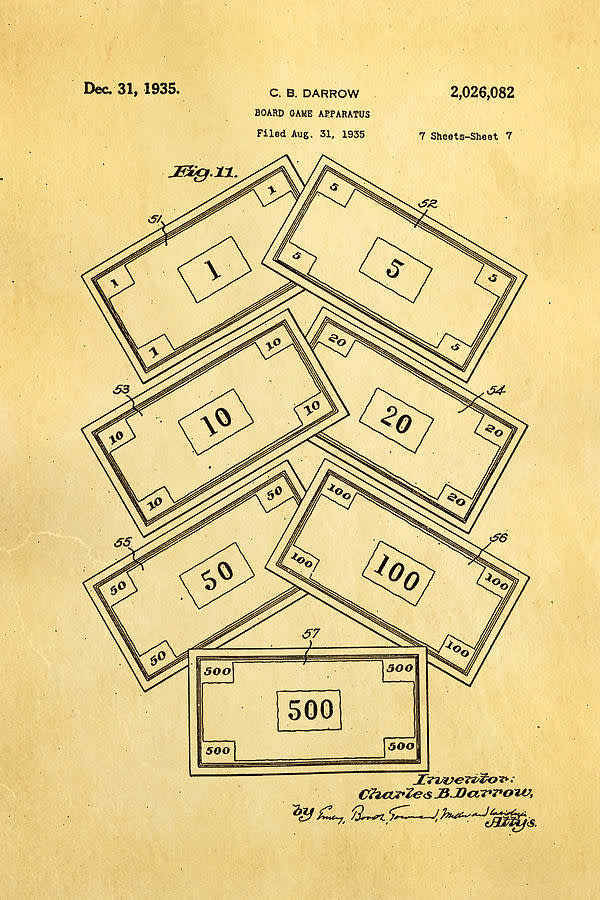
Monopoly
Original Patent

Monopoly Board
Contemporary Style

Monopoly
Star Wars Franchise

Monopoly
Pokemon Franchise

Monopoly
Sephora Franchise

Monopoly
Uncle Pennybags
Another game that promotes specific aspects of culture is the ever-popular, friendship-ending game of Monopoly. Dating back to 1903, Monopoly originated as “The Landlord’s Game,” created in the United States by Lizzie Magie as a way to promote the economic theories of Henry George and to illustrate the negative effects of private monopolies. Several versions of the game were created throughout the ensuing decades, until the Parker Brothers bought the patent for it in 1935, after which they introduced hundreds of variations of the classic board game; from junior versions for kids to more complex boards representing global domination. During World War II, a UK manufacturer created and distributed a special version of Monopoly for prisoners of war being held by the Nazis, which hid maps, compasses, money, and other useful objects inside, while in more recent years, thousands of franchises ranging from Star Wars and Pokemon to colleges and beauty brands have made their own, themed versions of the classic board game.

Mamluk
Egyptian, Playing Cards

Mamluk
Egyptian, Playing Cards

Early Playing Cards
Tibetan
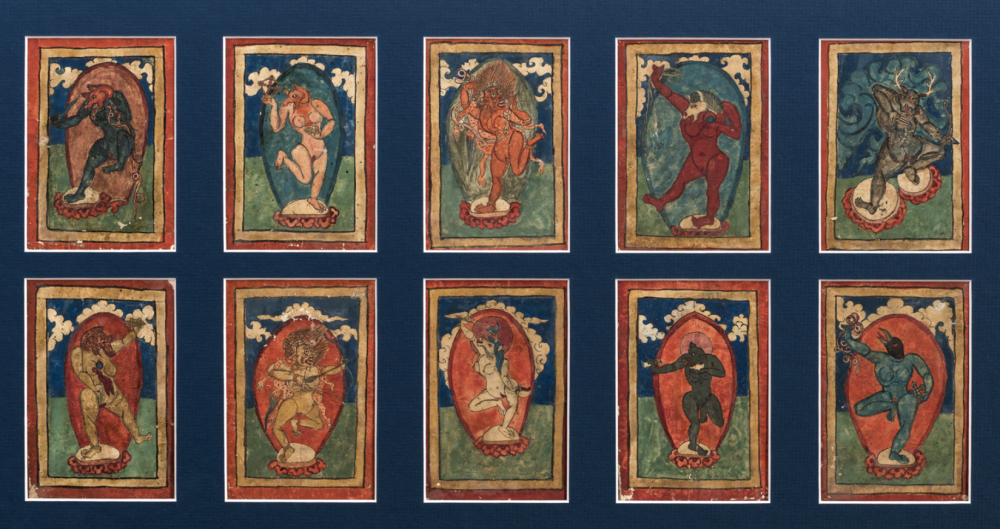
Early Playing Cards
Tibetan
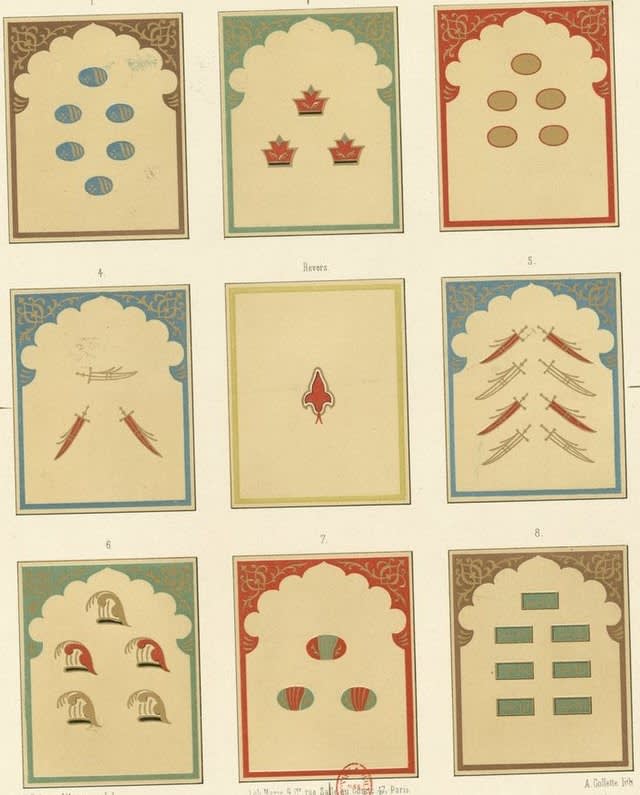
Granifa
Persian, Playing Cards

Playing Card
Swiss, 1367

The Queen of Flowers
Master of the Playing Cards, German, 1435-40

Cloister Playing Cards
South Netherlandish, 1475-80
Like chess, playing cards have a history of geographic influence across cultures, having undergone radical transformations since their beginning. Due to the fragile nature of paper, there is little evidence of the origin of playing cards, but historians agree that they likely originated in Asia around the 13th century; some early decks feature goblets, gold coins, swords, and polo sticks, linking them to the Egyptian Mamluk period. By the late 1300s, cards began appearing in Europe, hailing from the Arab world, and further developed from there. In 1377, a Swiss monk’s manuscript mentions playing cards as an example of denounced activities such as gambling, while the manuscript gives evidence for a 52-card deck with four suits from Italy. Italian court decks from the era were hand-painted luxury items only found among the upper class, though new production methods allowed the cards to be produced more cheaply and thus become more widely accessible.
Early Playing Cards
Four Suits, French, 1500s
L'Amerique Playing Cards
Jeu d'Or, French, 1700s
L'Asie Playing Cards
Jeu d'Or, French, 1700s
Salvador Dalí
Four Images of Club Cards, Suite Playing Cards, 1972
Salvador Dalí
Four Images of Club Cards, Suite Playing Cards, 1972
Sonia Delaunay
Simultané Playing Cards, 1967
Paul Cezanne
The Card Players, 1890-92
Georges Braque
Candlestick and Playing Cards on a Table, 1910
Juan Gris
Violin and Playing Cards on a Table, 1913
Maria Helena Vieira da Silva
Le jeu de cartes, 1937
George Condo
Playing Cards, 2011
Gucci
Playing Cards
In the 15th century, the French introduced the four suits that we use today – called couers, piques, carreaux, and trefles – in addition to developing clearer symbols and dividing the deck into red and black groupings, making them easier to replicate with stencil. The wide accessibility of French playing cards made them more popular, and the French suits spread throughout all of Europe and, eventually, to the United States. Much like chess, artists have taken inspiration from playing cards and put their own unique spin on the traditional symbols and suits. Salvador Dalí’s playing cards show off the artist’s surrealist style and Sonia Delaunay’s cards utilize her abstract, geometric, and colorful aesthetic. Meanwhile, George Condo’s deck morphs the style of his contemporaries—Andy Warhol, Jean-Michel Basquiat, and Keith Haring—with the works of classical masters to develop a unique and modern style. Even luxury fashion brands like Hermes and Gucci have developed playing cards as playful form of marketing.

Cory Arcangel
Super Mario Clouds, 2002

Cory Arcangel
Super Mario Clouds, 2002

Cory Arcangel
Super Mario Clouds, 2002

Space Invaders
Characters

Space Invader
Street Art

Space Invader
Street Art

Takashi Murakami
The Panda Says They're Happy, 2014

Takashi Murakami
Vapor Trail in the Blue Summer Sky, 2018
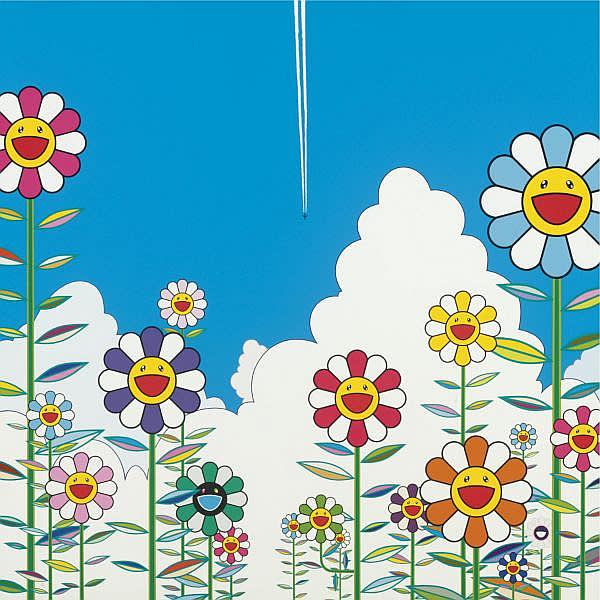
Takashi Murakami
A Summer Vapor Trail, 2018
The most modern variation of games dates back to the 1950s, when computer scientists began designing simple simulations as part of their research, eventually leading to the video games we have today. In the 1960s, computer games like tic-tac-toe were developed on IBM 1560 computers and played via punch cards, while video games reached mainstream popularity in the 1970s and 80s, thanks to early home consoles and the rise of arcade culture. During the 1980s and beyond, consoles were released in various generations, each more advanced then the last, while the 1990s saw the introduction of mobile phone gaming. Though it wasn’t until the early 2000s, due to growing accessibility, larger budgets, and better graphics, that the status of video games was permanently cemented in popular culture. Meanwhile, despite the constant reinvention of video platforms and new generation consoles, certain games such as Pac-Man, Pokemon, and Super Mario Bros seem to have been grandfathered into the gaming world indefinitely; the latter of which has been a notable source of inspiration for contemporary artists such as Cory Arcangel, Takashi Murakami and the French street artist known as ‘Space Invader’.
Games come in all shapes and sizes, from hand-painted paper cards and miniature moveable objects, to colorful boards and virtual computer graphics. They fade in and out of popularity, spread across nations, permeate cultures, and evolved over time, but despite their differences, the common mark of any good game seems to be achieving a balance between entertainment, community, competition, and education that will drive it into the future.



